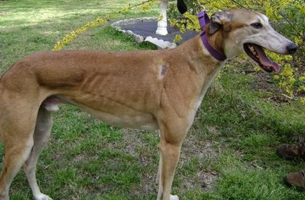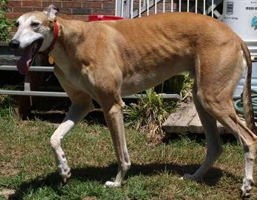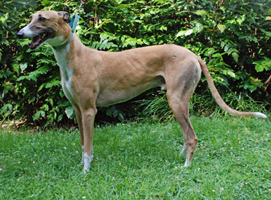I stumbled upon this article and thought I would share it with you. We use very similar guidelines for our adult athletes. They do have greyhound in them and can easily overheat if they are carrying too much weight.
A majority of people’s dogs are way too fat.
By Joanne Johnson of Greyhound Crossroads
How To Know If Your Greyhound Is At The Proper Weight
Obesity is a huge problem in dogs that WILL shorten your greyhound’s lifespan. Unfortunately fat dogs are everywhere now and we have gotten so used to seeing overweight dogs that most of us prefer not to see bones. About 33 percent of dogs are overweight. Most breeds of dogs are shown slightly overweight so that is what we see on the TV dog shows and is what most people think their dogs should look like. Greyhounds are supposed to look a lot thinner than most other breeds and are never supposed to look like Labradors. If you have a greyhound expect strangers to tell you your greyhound is too thin when it is at the perfect weight.
Freshly retired large male at a healthy 80lbs
Same male at obese 95lbs notice some ribs can still be seen
So how do you tell if your greyhound is at the proper weight? Your greyhound should have just the tips of his hipbones barely visible and the outline of a couple of ribs. If your greyhound is smooth across his hind end with no bones showing at all it is too fat. If it has no ribs visible it may be overweight depending on if it naturally has a very narrow ribcage or a more rounded rib cage. A dog with a more rounded ribcage like the one above can have the outline of ribs showing even when obese. If it doesn’t have a pronounced tuck (waist) it is definitely too fat. If your greyhound has put on 10, 15 or even more lbs above its racing weight it is overweight. Use your dog’s tattoes or racing name to find out your dog’s racing weight here:http://www.greyhound-data.com/
It is dangerous to race a fat greyhound and making sure a greyhound is racing at the proper weight is something that trainers and track officials take seriously. When greyhounds retire from the track they are at their most fit and muscular but many people think they look too thin. Like human athletes it is better for them to run thin than slightly overweight. It is better for your pet greyhound to be on the thin side than overweight too. Occasionally we do run into one that really raced too thin but those generally were hard keepers like the one below that just couldn’t keep weight on at the track.
Large male too thin at a race weight of 74lbs
Same male at 88lbs after vet recommended losing a few lbs
Unless your retired greyhound continues to participate in performance events like lure coursing or agility, it will lose a lot of muscle when it retires. That muscle will be replaced by fat. Muscle is heavier than fat so replacing 5lbs of muscle with 5lbs of fat will make your greyhound look less boney even if it doesn’t gain a pound over it’s racing weight. We have even seen a few dogs that looked overweight after retirement that didn’t gain a pound over their racing weight. Unless your greyhound was exceptionally thin at racing weight it is best to keep him within a couple of lbs of his racing weight for the rest of his life. Healthy weight IS healthy weight period. “Pet weight” should be thin and fit not fat and flabby. Retiring from racing and becoming a pet doesn’t mean your greyhound should gain 10lbs and be fat.
Most greyhounds still enjoy racing around in their yards occasionally or running with other greyhounds at one of our greyhound playgroups. Your greyhound will try to run at the speed it did when it was at the track and very fit. For a 50lb female to gain 10lbs is like a 150lb person gaining 30lbs. That is a LOT of extra weight to carry around and can lead to injury, heat stroke and even death.
Freshly retired female at 58lbs. A little too much hip showing but her racing weight was 60lbs which would be perfect. Same dog on right at an obese 80+lbs.
For a dog obesity is a weight 15% above their “optimal body weight”
Healthy Racing Weight……………………..Overweight……………….. Obese (dangerously overweight)
50lbs…………………………50-57.5 lbs………………………………57.5lbs+
55lbs…………………………55- 63.25lbs……………………………63.25lbs+
60lbs…………………………60-69lbs…………………………………….69lbs+
65lbs…………………………65-74.75lbs……………………………..74.75lbs+
70lbs…………………………70-80.5lbs………………………………..80.5lbs+
75lbs…………………………75-86.25lbs……………………………..86.25lbs+
80lbs………………………….80-92lbs……………………………………92lbs+
85lbs………………………….85-97.25lbs………………………………97.25lbs+
90lbs………………………….90-103.5lbs………………………………103.5lbs+
You are putting your greyhound’s health in jeopardy by letting it get fat. If it has passed the obese mark it is in serious trouble. Not all vets are familiar with greyhounds so they may not tell you to take weight off your greyhound until it is already obese. Just because your vet tells you your greyhound looks “fine” doesn’t mean it really is at the best weight for a healthy fit greyhound. A couple of lbs under ideal weight is better than a couple of lbs over unless your dog is older. It is hard to keep weight on most senior greyhounds.
This is a 78lb tall, narrow greyhound that is 30″ at the shoulder and is at the proper weight for his build.
How To Get The Weight Off
Cut back on your greyhound’s food for a couple of months to slowly get it back to the correct weight. That is the most caring and responsible thing thing you can do once you realize your greyhound has accidentally gotten overweight. The worst thing you can do is to continue to feed it every time it looks hungry and gives you sad eyes. Love your dog enough to do what is best for its’ health, even if you prefer not to see bones on a dog and think your greyhound looks better on the pudgy side. Resist that temptation to fatten up a greyhound!!
If you are free feeding your greyhound… stop. Like humans, greyhounds will be tempted to snack more if food is always within reach. It is better to feed regular meals so you can control how much your dog is getting and cut back if necessary.
How much do I feed? Most male greyhounds weigh 65 to 78lbs and do well on 2 cups of food fed twice daily (4 cups total) for maintenance. If your dog is fat you will need to feed LESS than this for awhile to get the weight off. Smaller females may need only a cup and a half of food or even less fed twice daily (3 cups total) to maintain their weight so would need to be fed even less to lose weight. A larger male or greyhound that gets a lot of exercise every day may need a little more. If your dog has been gaining weight on what you have been feeding you must cut back BELOW the maintenance level to get weight loss. Cutting back only to the mainenance amount will just make him stop gaining weight but will not allow him to lose weight. Once your dog has gotten to a good weight, the best way to keep him there is to do a daily hipbone and rib check and cut back on food a little if they start to disappear. Note: Fat rolls do not count as visible ribs!
Pay attention to treats and things you add to your dog’s meals. Adding a large milkbone or a handful of treats every day can be equal to a half a cup of additional food. If you give lots of treats you will have to cut back on meals to make up for it. If you add half a can of moist dog food to your kibble or half a cup of yogurt be sure to cut back on the amount of kibble. Some dogs like to chew on carrot sticks and those are great to use for treats instead of high calorie, high carb milkbones and cookies.
The food you are feeding can effect your dog’s weight as much as the amount you feed. You will need to feed less of rich foods because of the calories. You will also need to feed less of the cheaper foods because of the high amount of carbs from rice or corn that are used as a cheap filler. Protein builds muscle for dogs just like in humans and carbs can make your dog flabby. This is why the so called “diet” foods often don’t work very well to help your dog lose weight. They have too many carbs even though there may be fewer calories. It is better to feed less of a higher protein food than to feed a high carb, lower calorie food. Some people find it helpful to add low salt canned green beans or canned pumpkin (not pie filling) to their dog’s food. These are both low carb, low calorie, fiber rich foods that will make your dog feel more full without putting on the pounds.
Exercise is important for weightloss too. Getting more muscle on your dog is important because muscle burns more calories than fat, even when the dog is resting. Greyhounds are famous for being couch potatoes and getting no exercise at all is not healthy and is likely to cause them to look like a potato.
Would love to have more good before and after photos of greyhounds that have gained too much weight. I won’t use your name or your dog’s. Please send before AND after body shots to Joanne
Medium sized male at racing weight of 75lbs. Perfect!………………………At 83lbs after gaining 8lbs. You can really see how wide he is when he is laying down.














